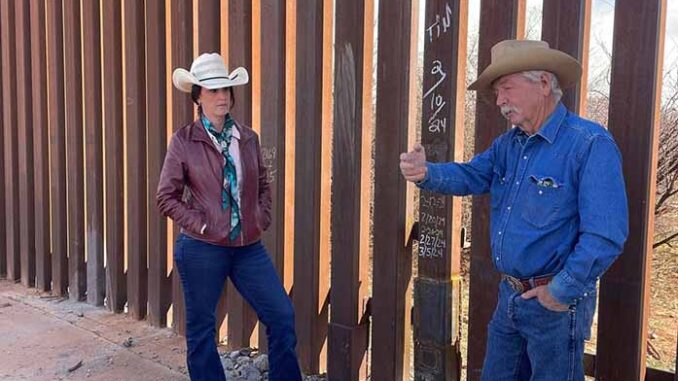
While there are plenty of disagreements on how to best handle the southern border crisis, it’s clear that people on the ground are asking for more support. On the state government side, sheriffs have played an increased role in the consequences that come from having high levels of cartel activity and a surge of migrants coming across daily.
The impact on border communities, whether it’s law enforcement or ranchers, continues to be jarring.
John Ladd of Hereford, Arizona, led a tour near his property along the southern border on Saturday with some members of the Arizona State Senate Republican delegation, The Center Square reported. Part of the wall near his property has regularly been breached, which can be seen with date markings along the wall’s slats.
When asked what he would like to see the state government do, he drew back to actions former Gov. Doug Ducey took.
“What Governor Ducey was doing was phenomenal. He was funding a lot of the Cochise County Sheriffs, the Yuma County, Pinal County, and also had DPS involved and patrolling the freeways between here and Phoenix,” Ladd said.
“And Hobbs is still doing that to a certain degree, but that’s it,” he added.
The rancher took a critical tone of the decision for current Gov. Katie Hobbs’ decision to support a busing program for migrants.
“And what she’s done is funded $300 million to reunite the illegals coming with their families, buses and plane tickets. And that’s a crime, in my opinion,” Ladd continued.
The rancher noted that his family used to occasionally assist migrants coming across years ago, but that is when border crossings were a much rarer occurrence and not in large numbers. The ranch has been in his family’s possession for well over a century, and he said border mismanagement has drastically hurt the property’s value since the 1980s.
“Send them back, deport ’em– You’re here illegally. And she’s funding them getting anywhere in the U.S. But the state has to have some responsibility and probably most of it is monetarily to support the counties that are gonna enforce the law and our sheriff’s doing it,” the rancher continued.
The Center Square reported in October that Hobbs said busing is part of easing up the impact on border communities.
The governor deployed National Guard troops to the border in December after the Lukeville Port of Entry temporarily closed. She’s also demanded the Biden administration to take further action at the border, and requested $1 million in her budget for a border security initiative known as “Operation SECURE.”
Still, there is plenty of room for dissent between the Democratic governor and Republicans in the legislature, as she vetoed the “Arizona Border Invasion Act” earlier this month. Senate Bill 1231 would have made it a state crime to enter the state through a non-legal port of entry. Legislative Republicans are now seeking to put similar border bills on her desk, as well as get other immigration policy proposals on the general election ballot.
One of the local efforts is the Southeastern Arizona Border Region Enforcement, which is under the purview of the Cochise County Sheriff’s Department. A detective with SABRE, Cody Essary, explained that in the Tucson Sector of the border, many of the people crossing “are looking to get away.”
“They’re wearing camouflage as they come across. They’re getting in vehicles; they’re running from law enforcement. They are not wanting to be caught. They’re not wanting to be processed for an asylum request, anything like that,” he explained, saying there’s a difference between Texas and the Yuma Sector compared with what he’s witnessed.
Essary noted how many state officials are aware of the need to support local authorities in border communities.
“Support. We’ve seen some high levels of support from the state government and even from the governor. A lot of them are aware of the issue that we’re seeing here and the problems that we’re having. Our big message is to any resources that are available. We’re able to put those to use,” Essary said.
“As we’re seeing increases in folks coming in the NGO network at their capacity, we’re continuing to provide support and that includes busing,” she said at the time.
Ultimately, he said this is up to the federal government to “enforce the law.”
“Give us the agents that we need, the assistance that we need, because this is a direct impact. And I think that we’re seeing it now in places outside of just border towns where this is now starting to affect them. We hear about New York City all the time, Chicago, those jurisdictions in those areas are now feeling the effects that we’ve been feeling every day for years,” he said.
The Tucson Sector is currently the border’s busiest, with 300,063 migrant encounters in fiscal year 2024 so far, according to Customs and Border Protection data.
